‘.... In the early 1840s a handful of pastoralists with their flocks of sheep and herds of cattle occupied the forests and plains of the Bangerang Aborigines.
Within a few years they had supplanted the original occupiers.
This was the first battle for the lush Barmah Forest; it was not to be the last ...’ 1
Straddling the central section of Australia’s Murray River, the Barmah-Millewa Forest is the largest river red gum forest in the world. It covers approximately 66,000 hectares of floodplain between the townships of Tocumwal, Deniliquin, and Echuca. South of the river, Victoria’s Barmah Forest comprises some 28,500 hectares.
The forests support important floodplain vegetation communities, including the threatened Moira grass plains, and are a significant feeding and breeding site for waterbirds, including bitterns, ibis, egrets, spoonbills, and night herons. Significant populations of native fish, frogs, and turtles also live in the forest’s waterways. Barmah Forest is known to support 74 plant and animal species protected under State and national legislation.
The Barmah and Millewa forests are recognized worldwide via Australia's signatory to various international treaties and agreements, including:
- CAMBA: China-Australia Migratory Birds Agreement.
- JAMBA: Japan-Australia Migratory Birds Agreement.
- A RAMSAR TREATY: for protection of designated wetlands of international significance.
- A UNESCO TREATY: for protection of wetlands in Barmah Forest.
A New Information Centre and Accommodation Hub
In late 1983 the Division of Forests, in the Department of Conservation, Forests, and Lands, sought a federal Community Employment Program grant of $383,600 for the construction of an interpretation complex in the Barmah State Forest
The rationale behind the bid included providing opportunities to develop a facility which would enhance community appreciation of the forest and its associated ecosystems, assist in the interpretation and appreciation of local Aboriginal culture, and portray the range of community demands that were being made of the area at the time. The latter included timber harvesting, cattle grazing, bee-keeping, recreation and tourism. The proposal included a commitment to create employment for members of the local Aboriginal community during the construction of the Centre and an associated Camp.
The Federal Ministry of Employment and Training approved the project in early 1984, the funding being conditional on matters including the project’s scope, timeframe, and intercommunity relationships.
From the outset the Department, in seeking to create a community facility, sought to involve the local Aboriginal community (through the Bangerang Keeping Place at Shepparton, and the Yorta Yorta Tribal Council), and the residents of the wider area (through the local Nathalia Shire). The first related meetings were held in the forest in February 1984.
The Yorta Yorta Tribal Council moved quickly and on the 25th of February 1984 gave unanimous support to the community employment program subject to several conditions. These included community input into the design of the building; the Centre’s location to protect sacred sites; participation in the employment process, with employment opportunities being available for both qualified and unqualified Aboriginal workers; and consultation on future management and control of the Barmah Forest.
The security of significant funding provided by the Commonwealth gave confidence to all, although not without some trepidation about the scope, timeframe and relationships required to bring the concept to fruition.
Negotiations involving both the Tribal Council and the Shire continued and, in late 1984, it was agreed that an Advisory Committee would be established. It was to comprise three nominated members from the Yorta Yorta Tribal Council 3 plus two observers, and three nominated members from the Nathalia Shire Council and two observers. The Committee was to be appointed by Victoria’s Minister for Conservation, Forests and Lands and convened by an officer of the Department. 4
Proposed Terms of Reference for the Advisory Committee were developed, and subsequently agreed to and approved by the Minister. The Committee was to:
- Provide a means for expression of community views concerning the establishment and future management of the Centre and Camp and for the communication of these views to the Department and the Minister for Conservation, Forests and Lands.
- Advise on a suitable location for the complex.
- Liaise with the architects regarding design and layout of the complex.
- Formulate proposals for future management and use of the complex for communication to the Minister.

Dharnya - The Concept
The Centre Takes Shape
Under the Committee’s guidance designs were prepared for an Interpretative Centre, a Bunkhouse with a 50-bed capacity, a Cookhouse, and associated landscaping. Construction commenced in February 1985 and was completed late that year; the Centre officially opening on December 18th, 1985.
The Centre started operating in early 1986 under criteria developed by the Advisory Committee and approved by successive Victorian Ministers. Draft aims were developed by the Advisory Committee and, following unanimous agreement, were put to the Minister for approval. The aims were to facilitate a greater community understanding of:
- The ecology of red gum forests and the importance of their conservation.
- The uniqueness and need for preservation of Aboriginal culture in the area.
- The continuum of human occupation in the Murray Valley - both Aboriginal and European.
- The past, present, and future management, and uses of the forest in the interests of the whole community.
In addition, the Centre was established to:
- Act as a focal point for day visitors to the forest.
- Provide a focus for community interest in ecological and cultural matters pertaining to the central Murray River forests.
- Serve as a Centre to assist in the training of Aboriginal rangers, cultural officers, and site recorders.
- Develop and maintain strong links with the Aboriginal Keeping Place at Shepparton.
Based on advice from Aboriginal members of the Committee the following Centre and building names were agreed:
- For the whole complex (the Centre): THE DHARNYA CENTRE, BARMAH FOREST. (Dharnya being understood to be the local Aboriginal word for Red Gum).
- The Interpretative Centre: YORTA YORTA INTERPRETATIVE CENTRE (Lodgjiba). (“lodgjiba” literal translation, to speak or to impart knowledge which is the essence of teaching and learning).
- The Bunkhouse: GUMBAH (the local word for sleeping place)
- The Mess Hut: MALOGA – JALGA (literally translated Maloga means “sand” and became the name given to sugar; Jalga translated means “dry leaves” and became the name for tea leaf).
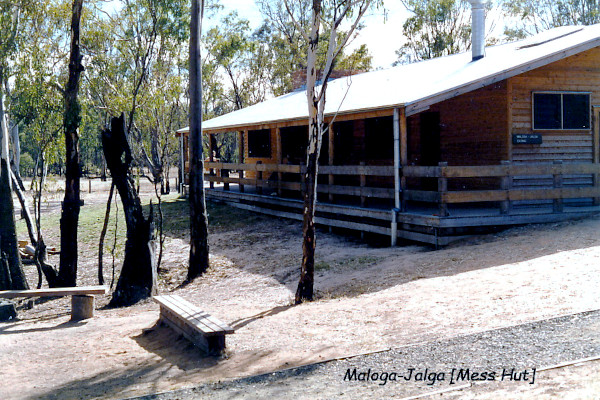
The Mess Hut
1987
Source: B Dexter

The Bunk House & Interpretative Centre
1987
Source: B Dexter
Community Support
As building construction work neared competition, the wider community started to step-up. Aboriginal artefacts, and photographs were donated to the Centre, Advisory Committee representatives being actively involved in obtaining these donations. Offerings included two canoe trees, located on the lands of local farmers, which were relocated to the environs of the Centre with the approval of the Yorta Yorta representatives.
Funding was provided by the Timber Promotion Council (Victoria), and the Victoria Archaeological Survey organisation to ensure this venture was carried out successfully, so that the trees were preserved for future generations. The Centre also received several grants from the Department, and the Timber Promotion Council to fund displays, including a diorama. Over $50,000 was provided for the development of a native garden. Displays depicting Aboriginal culture and history, forest wetlands, regional geomorphology, aspects of natural history and forest utilization and management were developed and installed.
Open for Business
Somewhat off the beaten track, and a three-hour drive from Melbourne, there were a few sceptics in terms of the Centre’s viability. But as news of its existence spread, and of the educational opportunities it offered, usage started to grow.
In 1987 and 1988, successful Open Days were run in Autumn, the first being attended by Minister Joan Kirner, and the Department’s Acting Director-General. At both Days a number of community groups were involved in providing a variety of attractions including bush walks, Aboriginal cooking, Aboriginal dancing, broad-axe cutting displays, environmental games, emu egg carving, boomerang throwing, wood turning/carving, red gum furniture display, and a cattle muster yard demonstration. As a contribution to the first Open Day, and despite typical lower autumn river flow and diversions, the River Murray Commission managed water levels to allow a paddle steamer to pass Barmah Bridge and berth at the Lakes. Many people provided considerable voluntary assistance.
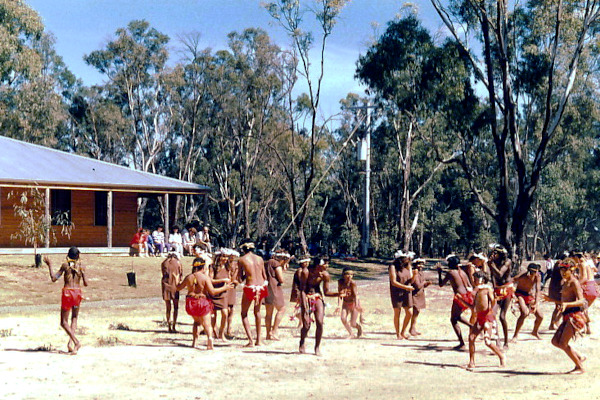
Open Day
22 March 1987
Source: B Dexter
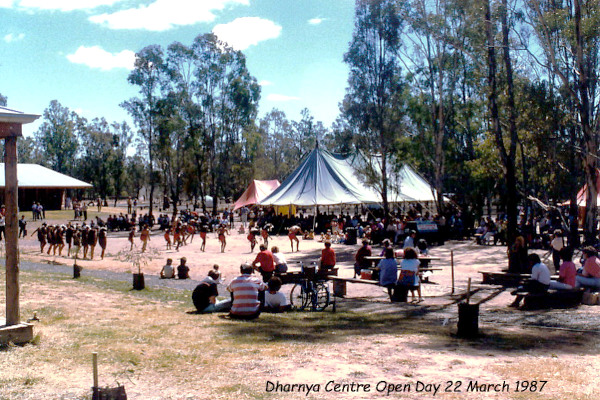
Open Day
22 March 1987
Source: B Dexter
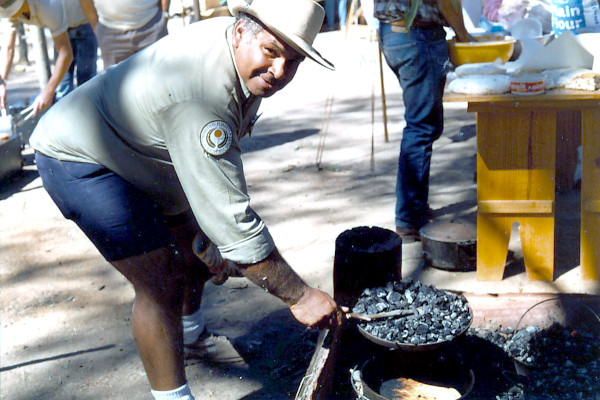
Eddie Kneebone at the first Open Day
22 March 1987
Source: B Dexter
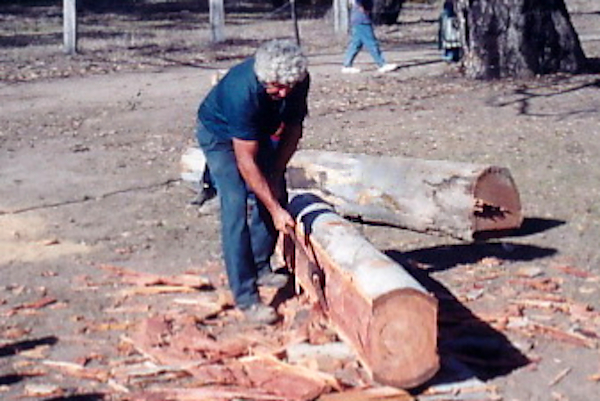
Gary (Curly) Rosenow at the first Open Day
Sleeper Cutting
22 March 1987
Source: B Dexter
In 1987, the Centre was awarded the best museum, Category B Award in the national Museum of the Year awards. The winning citation read:
“Dharnya Centre: for the effective blending of two human cultures within a changing natural environment, conveyed through an innovative Visitor Centre and an imaginative range of outdoor activities and special events.”
By 1991, annual visitors to the Interpretative Centre were maintaining at around the 12000-13000, while accommodation numbers were averaging in excess of 4000.
Shifting Perceptions
By the late1980s the Centre operated as part of the management responsibilities of the Department's Benalla Region. A manager and two cultural officers were employed full-time, while the Centre was also used for the then Aboriginal ranger training program.
In June 1992, the High Court of Australia recognised that a group of Torres Strait Islanders, led by Eddie Mabo, held ownership of Mer (Murray Island). The Mabo decision was a turning point for First Nations rights and led to the Australian Parliament passing the Native Title Act in 1993. Native title is the legal recognition that some First Nations people have rights to certain land through their traditional laws and customs, which predated the British.
One of the first claims under the 1993 legislation was made by the Yorta Yorta people in February 1994. Native title was sought over 1,840 square kilometres of their traditional lands. As Yorta Yorta country has been heavily colonised by non-Indigenous people, the claim was seen as a test case to show the likely success of native title applications in such areas of Australia. 5
Back at Dharnya, and by early 1990, differences were emerging among members of the Advisory Committee. Some Yorta Yorta representatives wanted total control over the Centre (and the entire forest) and were uncomfortable with the Centre’s approach in which Aboriginal history and culture were depicted along with more recent European/Australian history. More generally, there was frustration with perceived delays in the implementation, by the Department, of Advisory Committee recommendations.
In December 1990 the Yorta Yorta Murray Goulburn River Clans Inc. informed the Minister that they had decided “to withdraw their membership and support from the Committee”. The following year the Minister, Steve Crabb, abolished the Advisory Committee without consultation with the local Shire, or any attempt at conciliation. A new Committee of Management was created, involving the then Department, and the Yorta Yorta Murray Goulburn Clans Inc. In August 1991, a Dharnya Centre Special Purpose Reserve was gazetted under section 50(1) of the Forests Act 1958.
Postscript
In June 2004 the Victorian Government entered into a co-operative management agreement with the Yorta Yorta Aboriginal Corporation over certain public lands that formed part of their native title claim area.
In July 2021 the Victorian Government announced ‘... A significant milestone in recognising the rights of the Yorta Yorta Traditional Owners in caring for country was reached today, with the launch of a Joint Management Plan for Barmah National Park ...’ The media release also advised that ‘... The Government has also provided more than $3.4 million for renovations to the Dharnya Centre. Construction of a conference facility with meeting rooms and an industrial kitchen, group accommodation, site manager’s house and landscaping are expected to be completed by July 2022 ...’
A new era has begun.
Footnotes
1 Fahey C. (1986). Barmah Forest – A History. Department of Conservation, Forests and Lands.
2 Dexter, B. (1994). VNPA Field Meeting – Dharnya Centre. Background Notes.
3 The Bangerang collective of tribes, or nation, also known as the Yorta Yorta, consists of eight groups, according to the anthropologist, archaeologist, entomologist, and ethnologist, Norman Tindale, though opinions now vary somewhat. See: Tindale, Norman Barnett (1974). "Pangerang (VIC)". Aboriginal Tribes of Australia: Their Terrain, Environmental Controls, Distribution, Limits, and Proper Names. Australian National University Press.
4 Between late-1984 and 1991 the convenor was Barrie Dexter, with administrative support for much of that period being provided by Mike Leonard.
5 In 1998, the Federal Court rejected the claim. Justice Howard Olney ruled that the Yorta Yorta had not maintained the necessary connection to their traditional Country. In December 2002, a High Court appeal by the claimants was not upheld.
